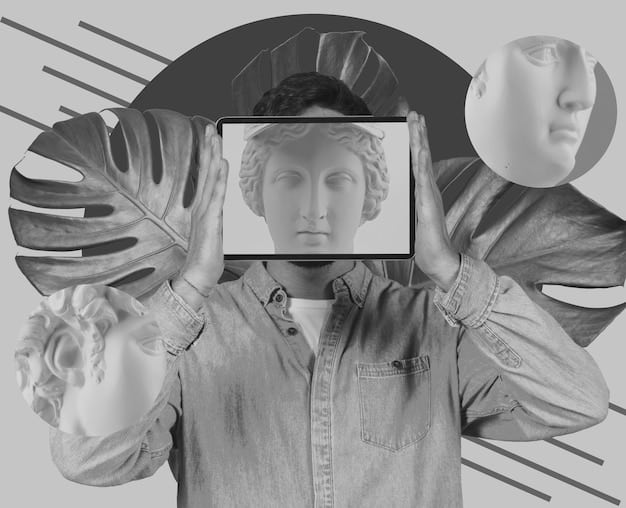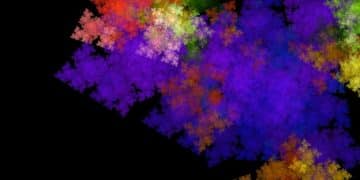Decoding Symbolism: Unveiling Hidden Meanings in Series Reviews

Decoding the Symbolism: A Deep Dive into the Hidden Meanings of examines how recurring motifs, visual cues, and narrative choices in popular series enrich storytelling, offering profound insights into themes and character development.
Dive deep into the captivating world of series reviews and uncover the rich tapestry of hidden meanings. Decoding the Symbolism: A Deep Dive into the Hidden Meanings of, allows us to understand the recurring motifs and subtle visual cues that enrich storytelling and deepen our appreciation for the art of narrative.
The Power of Symbolism in Storytelling
Symbolism is a powerful tool that storytellers use to add depth and layers of meaning to their narratives. It allows them to communicate complex ideas and emotions in a concise and impactful way. When we begin decoding the symbolism, we can unlock a deeper understanding of the themes and messages conveyed in a series.
Why Symbolism Matters
Symbolism enriches storytelling in several ways. Firstly, it adds depth by allowing the writer to convey more complex themes and ideas through simple cues and objects. Secondly, it creates a more engaging and immersive experience for the audience, inviting viewers or readers to actively participate in uncovering the hidden meanings. Finally, it can add emotional resonance, making certain scenes or moments particularly impactful.
Common Types of Symbols
Symbols can take many forms, often including universal signifiers understood across different cultures. Archetypal symbols include light and darkness denoting good and evil respectively, water representing purification or rebirth. Understanding these will aid in decoding the symbolism and improve the viewing or reading experience.

- Colors: Colors carry significant symbolic weight. Red might represent passion or danger, blue often symbolizes peace or sadness, and green is frequently associated with nature or growth.
- Objects: Everyday objects can take on symbolic meanings within a story. A key might represent opportunity or a secret, while a clock could symbolize time running out.
- Characters: Certain characters might embody specific concepts. A mentor figure could symbolize wisdom, while an antagonist might represent chaos or destruction.
- Settings: The setting itself can be symbolic. A dark forest might represent the unknown or a character’s inner turmoil, while a sunny meadow could symbolize hope or renewal.
By mastering these symbols, viewers and readers can understand the nuances of the narrative. This is the essence of decoding the symbolism and appreciating artistic creation.
Identifying Recurring Motifs
Recurring motifs are patterns or elements that appear repeatedly throughout a series. These are not just random occurrences; they are carefully placed to reinforce themes or provide insight into the characters.
What are Recurring Motifs?
Recurring motifs can be visual, auditory, or narrative elements. They are intentionally repeated to emphasize certain aspects of the story, deepening the narrative’s complexity. For example, a specific melody might play whenever a character faces a difficult decision, or a visual element like a broken mirror might appear whenever a character’s identity is questioned.
Examples of Recurring Motifs
Many notable series use recurring themes to enhance their narratives. In “Breaking Bad,” the color yellow appears frequently to symbolize caution or contamination. The constant ticking of clocks in “Mr. Robot” emphasizes the themes of time and anxiety. Recognizing and decoding the symbolism will improve the overall engagement with stories.
- Visual Motifs: These include recurring images, colors, or patterns. The red scarf in “The Americans” symbolized danger and deception, appearing each time a character engaged in espionage.
- Auditory Motifs: These involve recurring sounds, music, or phrases. The distinct theme song in “Stranger Things” evokes a sense of nostalgia and mystery.
- Narrative Motifs: These are recurring plot elements or situations. The frequent flashbacks in “Lost” slowly reveal the characters’ backstories and motivations.
Identifying these is key to fully understand the implications the writers wish to convey, assisting in decoding the symbolism and understanding the story.
Analyzing Visual Cues
Visual cues are non-verbal elements that communicate information subtly to the audience. These can include everything from camera angles to costume choices, each adding layers to the storyline.
The Role of Visual Cues
Visual cues enrich storytelling beyond simple dialogue or plot points. Camera angles can show power dynamics, where close-ups detail specific character emotions. An individual’s attire can convey character or background. The mastery of decoding the symbolism from these cues adds breadth to interpretation.
Examples in Popular Series
Series like “The Queen’s Gambit” use visual cues extensively to portray the protagonist’s mental state and strategic thinking. The clothing signifies her progression and status, while the chess pieces take on life-like qualities, mirroring the inner conflicts. Similarly, “Mad Men” employs visual elements to underline the themes of identity and societal change.

A deeper understanding of visual cues elevates the audience’s narrative engagement, making decoding the symbolism an intellectual yet satisfying activity.
Interpreting Character Symbolism
Characters often symbolize broader themes or ideas within a series. Their traits, arcs, and relationships can represent complex concepts that resonate deeply with viewers.
Characters as Symbols
Characters can personify concepts, emotions, or societal roles beyond their apparent function in a narrative. These symbolic figures deepen how we engage the content, providing a framework for understanding wider narrative and thematic elements. Decoding the symbolism in characters therefore unlocks deeper story layers.
Examples in Various Series
Examine several series’ character symbolism for clarity. Walter White from “Breaking Bad” represents transformation and the dangers of unchecked ambition, while Daenerys Targaryen in “Game of Thrones” symbolizes power with benevolent intentions turned to tyranny. Further inspection shows the vast range and depth of character symbols.
By identifying those symbols, viewers gain a clearer perspective on the stories, enriching the overall significance through actively decoding the symbolism.
The Significance of Setting
The setting is more than just a backdrop; it is an active element that contributes significantly to the overall meaning and tone of a series. The environment in which a story unfolds can symbolize themes, emotions, and character states.
- Reflecting Inner States: The setting often mirrors a character’s internal landscape. A desolate, barren landscape might reflect a character’s feelings of isolation or despair.
- Symbolizing Themes: The setting can also represent the broader themes of the series. A futuristic, dystopian city might symbolize the dangers of technological advancement or social control.
- Creating Atmosphere: The setting is crucial in establishing the mood and tone of the series. A dimly lit, gothic mansion can create a sense of mystery and foreboding. Consider the setting a complex component to decoding the symbolism.
Consider the grimy, treacherous streets of “The Wire,” which symbolize institutional failure and the loss of innocence. Likewise, the opulent estates in “Succession” illustrate the isolation and moral bankruptcy of affluent families.
The Use of Color as Symbolism
Color is an intense medium of symbolism. Often used by filmmakers as a visual language, colors and hues deeply change understanding and emotional resonance within a series. The proper interpretation of color symbolism supports the holistic appreciation of any series.
Common Color Associations
Specific colors have universally recognized symbolic meanings. Red represents enthusiasm or danger, blue often represents tranquility, green represents peace and development. Series carefully arrange their color palettes to reinforce core narrative themes. Therefore, to decode the symbolism, start with the colors.
Examples in TV Series
Series such as “Squid Game” use color to highlight contrasts in status and intentions, using colors symbolizing both innocence and danger. Similarly, the vivid and bold hues in “Euphoria” mirror the emotional states of their respective protagonists. Using color in a deliberate fashion allows filmmakers to communicate on a subconscious level, enriching the complexity and resonance of visual narrative.
Decoding Symbolism and Narrative Depth
Ultimately, decoding symbolism enhances entertainment and depth of comprehension. By learning to recognize patterns, understand visual cues, and interpret character roles, viewers unlock richer, multilayered stories that reward meaningful interaction. Actively analyzing symbols turns passive watching into an energetic investigative activity.
| Key Point | Brief Description |
|---|---|
| 🎨 Color Symbolism | Colors often represent emotions, themes, or character traits, adding layers to storytelling. |
| 🎭 Character Archetypes | Characters frequently embody deeper concepts, moral standpoints, or societal roles. |
| 🎬 Visual Cues | Camera angles, costumes, and props serve to communicate subtly without explicit dialogue. |
| 🔄 Recurring Motifs | Repeated elements enhance themes and insights, creating a narrative throughline. |
Frequently Asked Questions
▼
Symbolism involves using objects, characters, or colors to represent deeper meanings or ideas. It adds layers of narrative that invite viewers to interpret and engage more deeply with the storyline.
▼
Decoding symbolism reveals the underlying themes and messages, enriching the viewing experience. It fosters a deeper appreciation for the storytelling and artistic decisions made by the creators.
▼
Look for elements like images or sounds that reappear consistently throughout the series. Recurring motifs usually highlight key themes or insights into characters’ journeys and developments.
▼
Visual cues like camera shots and costumes communicate subtly, adding layers beyond simple dialogue. These cues can suggest power dynamics or character backgrounds without explicitly stating them.
▼
Yes, characters often embody symbols, representing wider societal and emotional themes. A character might symbolize transformation, hope, and courage in certain roles, providing deeper narrative context.
Conclusion
Decoding symbolism is a rewarding process that enhances the depth and understanding of any series. By examining recurring motifs, visual cues, character archetypes, and the nuances of color and setting, viewers can uncover layers of meaning and elevate their appreciation for the art of storytelling.





